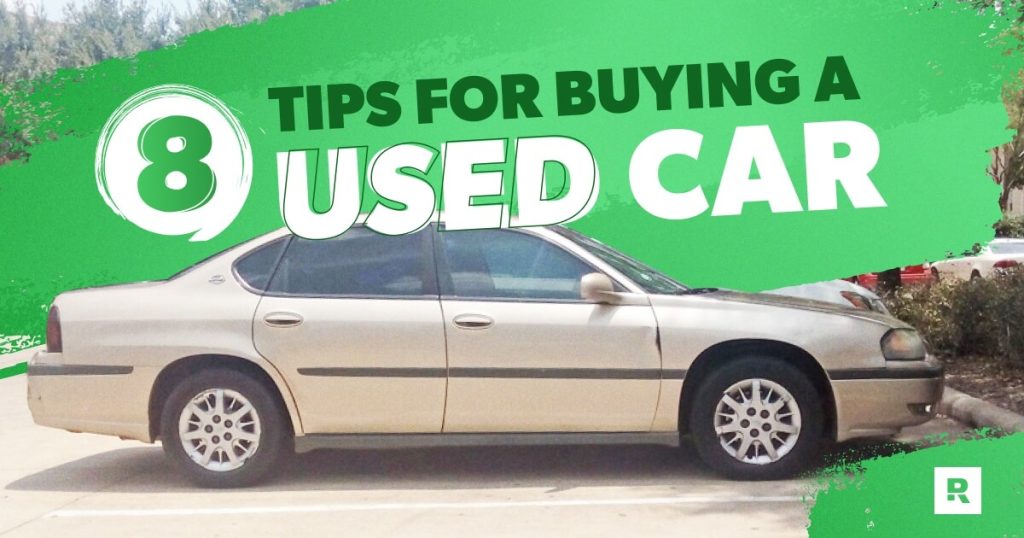We know what you’re thinking: The used car market is crazy right now!
But believe it or not, reliable used cars aren’t extinct. There are still plenty of options available—even in your price range!
We’re going to walk you through the best way to buy a used car (because, trust us, there are plenty of wrong ways out there) so you can drive off in your preloved ride with no regrets.
How to Buy a Used Car
Buying a used car instead of a brand-new car is definitely the smartest option financially (so kudos to you for going that route). But it still comes with a few risks. And if you don’t do your research, you could pay more than you should for your car—or even worse, end up with a used car that’s a total piece of junk.
These eight tips for buying a used car will help steer you in the right direction:
- Decide how much to spend.
- Find the right used car.
- Shop around.
- Figure out how much the car is worth.
- Inspect the car yourself.
- Go for a test-drive.
- Get an inspection by a mechanic.
- Negotiate the price.
Step 1: Decide how much to spend.
First things first: You need to know how much car you can afford. Just so we’re clear, we’re not talking about car payments here. Your goal should be to pay for a car—in full—with cash. As in, 100% down. And yes, it’s totally possible!
Now, you may have to scale back on price or save up for the car you want. But you’ll avoid having a crazy monthly car payment. Plus, you’ll save yourself thousands of dollars in interest (no joke). For example, let’s say you borrow $10,000 for a car with a 9.34% interest rate (the average) and a term of five years.1 You’ll end up spending an additional $2,554 in interest!
Listen, you don’t need to take out a car loan. You can find reliable used cars in any price range. If you’re real strapped for cash, look for a vehicle to get you from point A to point B for as low as $1,000 to $2,000. It may not be pretty, but you’ll get by.
Or if your current car can last you a while longer, take all that money you would’ve wasted on a car payment each month and save for an upgrade at a later date. Just make it a priority in your budget!
Step 2: Find the right used car.
Once you’ve decided how much you’re going to spend, it’s time to find the right car. Not your dream car. The right car for you right now. It’s the one that best fits your lifestyle and your budget.
Before you declare your loyalty to your favorite car brand, step back and take a look at the kinds of vehicles out there and what each was designed to do.
Trucks, for instance, were designed to carry goods and heavy materials. So unless you’re Bob the Builder hauling heavy cargo on a regular basis (you know—gravel, timber, bricks), you probably don’t need a truck. For a good commuter vehicle, stick with options that are compact and energy efficient, like sedans, hatchbacks or hybrids.
Dave’s easiest money-saving tip: See if you’re over paying for car insurance.
Here’s a quick checklist to help you narrow down your choices. Pick three things that are the most important to you when buying a used car.
- I want a vehicle with plenty of cargo space.
- I want a vehicle that can fit more people.
- I want a vehicle with better fuel economy.
- I want a vehicle that’s easy to get in and out of.
- I want a vehicle that’s safe.
- I want a vehicle that’s better for the environment.
- I want a vehicle that can carry heavy cargo.
- I want a vehicle that can go off-road or on rough terrain.
- I want vehicle that’s compact and light for city parking.
- I want a vehicle that has towing capacities.
Remember, you won’t find a vehicle that checks every box. Be honest with yourself about your wants versus your needs, and think long term about how you’ll use your car.
Also, you can save some money by getting rid of features you don’t need your car to have. Not just technology like GPS, Bluetooth connectivity and backup cameras—but the basics too. Can you survive with a two-cylinder engine over a four cylinder? Do you really need all-wheel drive? Stick-shift transmissions are also cheaper (if you don’t mind the learning curve).
Now that you know how much you can spend and what kind of car you need, you’re ready to start shopping. There are plenty of places to buy used cars (each with their own pros and cons).
Just don’t jump on the first offer you see! Take the time to compare different options and see what’s out there.
Here are some places to start your used car search:
- CarMax
- Edmunds
- Cars.com
- Carvana
- Craigslist
- Autotrader
- Independent used car dealerships
- Showroom lawns
Step 4: Figure out how much the car is worth.
Once you’ve shopped around and narrowed down your options, you need to figure out if the used car you’ve chosen is worth the price. Dig up all the information you can on the car so you can talk the seller down to a better deal.
1. Start with Kelley Blue Book (KBB).
KBB uses data from actual sales and auction prices to give you a realistic price range.
2. Buy a vehicle history report (VHR).
A good VHR costs about $50 and gives you accident history, ownership history and a ton of other records. It takes a lot of guesswork out of buying a used car. All you need is the vehicle identification number (VIN) for a detailed report.
3. Determine the ownership cost.
What will you have to spend to maintain the car (oil changes, new tires, fluid flushes), and what long-term repairs should you expect for the make and model you’re looking at? Also, what’s the average cost for replacement parts and repairs? You can use the Edmunds True Cost to Own tool to get a good estimate for all of that.
4.Read used car forums.
Nearly every car model has an online forum with reviews going back a while. Look for common issues that owners have had with the type of car you want to buy.
5. Check the vehicle’s recall history.
Don’t assume the seller has taken care of a used car’s safety recalls. In fact, over 72 million U.S. vehicles have open recalls on them—that’s 23% of all cars on the road!2 And yep, you guessed it—people still try to sell those cars without getting the recall fixed. So, what can you do? Check the National Highway Traffic Safety Administration for your vehicle’s recall history (if it has one).
6. Get an insurance quote.
Don’t forget to factor in car insurance! Good news for you: Used cars are normally cheaper to insure than new ones. In fact, a 5-year-old car is about 27% less expensive to insure than its brand-new counterpart.3 But ask if your premium will change based on a different make or model.
Step 5: Inspect the car yourself.
Even if you’re not a mechanic, you can still find some of the more obvious car issues yourself by giving it a good once-over and asking the right questions. Not every problem has to stop you from buying the car—unless it’s something major like a blown head gasket (yeah, that just sounds expensive). But you also don’t want to buy somebody else’s car problems.
Here are some things to check when inspecting a used car yourself. (You can also use this full inspection list from the Department of Motor Vehicles.)
Under the Hood
- Check the oil level and color.
- Check the color of the oil under the oil cap.
- Check the transmission fluid dipstick.
- Check the level of the coolant.
Outside
- Look at the car’s paint job.
- Open and close the doors, trunk, fuel door and fuel cap.
Inside
- Check the wear on the steering wheel, seats and pedals.
- Lock and unlock all the doors.
- Idle the car and watch the temperature gauge.
Step 6: Go for a test-drive.
It’s one thing to look over a car, but you also need to get a good feel for how it drives before you buy.
When you’re taking the car for a spin, turn off the stereo so you can hear any weird noises. Pick a route with hills, bumps and, yep, even potholes. (Just don’t go all Fast and Furious and return the car in worse shape.)
Use your test-drive to answer these questions:
Feel
- How does the car feel on flat roads?
- How does it feel when it hits a bump or pothole?
- Does it struggle to pick up speed?
- Do the gears change smoothly?
- Are the brakes squishy or too sensitive?
- How does your body feel after the test-drive?
Noise
- Does the engine sound smooth when you accelerate?
- Does the engine rattle, knock or grind when you idle?
- Are there vibrations or odd sounds under the hood when you accelerate above 60 mph?
- Do the brakes squeak?
Sight
- Can you see out of the car easily?
- Does black smoke come out of the exhaust when you start the car or accelerate?
- Is the RPM gauge consistent when you idle?
Smell
- Does the inside of the car smell like smoke?
- Dial down the air conditioning—do you smell burning oil?
Step 7: Get an inspection by a mechanic.
If the car has passed your personal inspection, good. But always have a mechanic inspect a used car, no matter the condition. A good mechanic will tell if you’re about to buy a reliable used car or a hunk of junk. And if the seller doesn’t want a mechanic to inspect the car, that’s probably a red flag the car has a major problem you should avoid.
When it comes to inspections, you have two options:
- Take the car to a trustworthy garage. Most car garages charge a flat fee for inspecting used cars. They’ll check the car out and tell you what’s going on.
- Set up a mobile inspection. A mechanic will come to the car, do the inspection, and print out the results.
If a mechanic tells you the car has damages that outweigh its value, let the seller know you’re no longer interested. Or use that knowledge to lower the asking price—just know you’ll have to spend money fixing those issues at some point.
Step 8: Negotiate the price.
For a lot of people, this is their least favorite part of the used-car buying process. Hey, we get it. Maybe you’re just not the haggling type. But you don’t have to be Mark Cuban to talk a used car salesman into giving you a good deal.
When negotiating the best price on a car, just remember to bring your research to the table, pay in cash (no matter what offers get thrown your way), take your time, and don’t be afraid to walk away!
Don’t Forget: Get the Right Car Insurance
Hey! Congrats on the new-to-you car you just bought. URRRRRRRT! SMASH!
Nobody expects an accident—which is why you need to be insured the moment you drive off in that new ride. But with so many types of car insurance available, it’s easy to spend more money than your coverage is worth.
You need an expert in your corner who can answer your questions, run the numbers, and compare different rates. That’s why you should connect with a RamseyTrusted insurance pro!
RamseyTrusted pros work with multiple insurance companies to find you the right coverage at the right price. We’ve vetted them, and you can trust that they’ll walk you through the whole process step by step—so you can feel more at peace behind the wheel.
Make sure you and your family have the coverage you need to protect yourself and your (paid-for) used car. Find an insurance pro today!
Read the full article here










